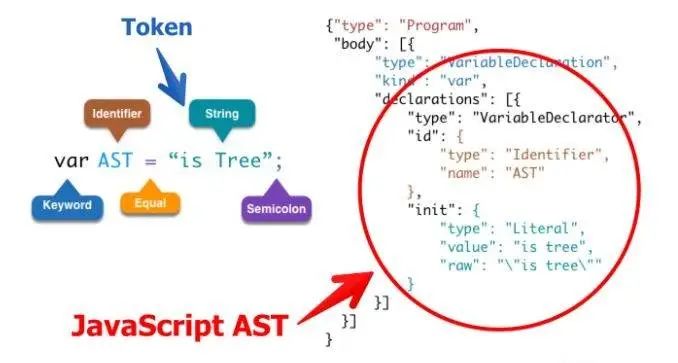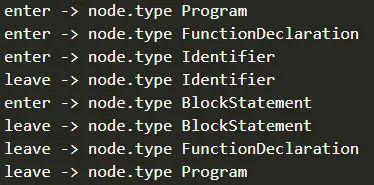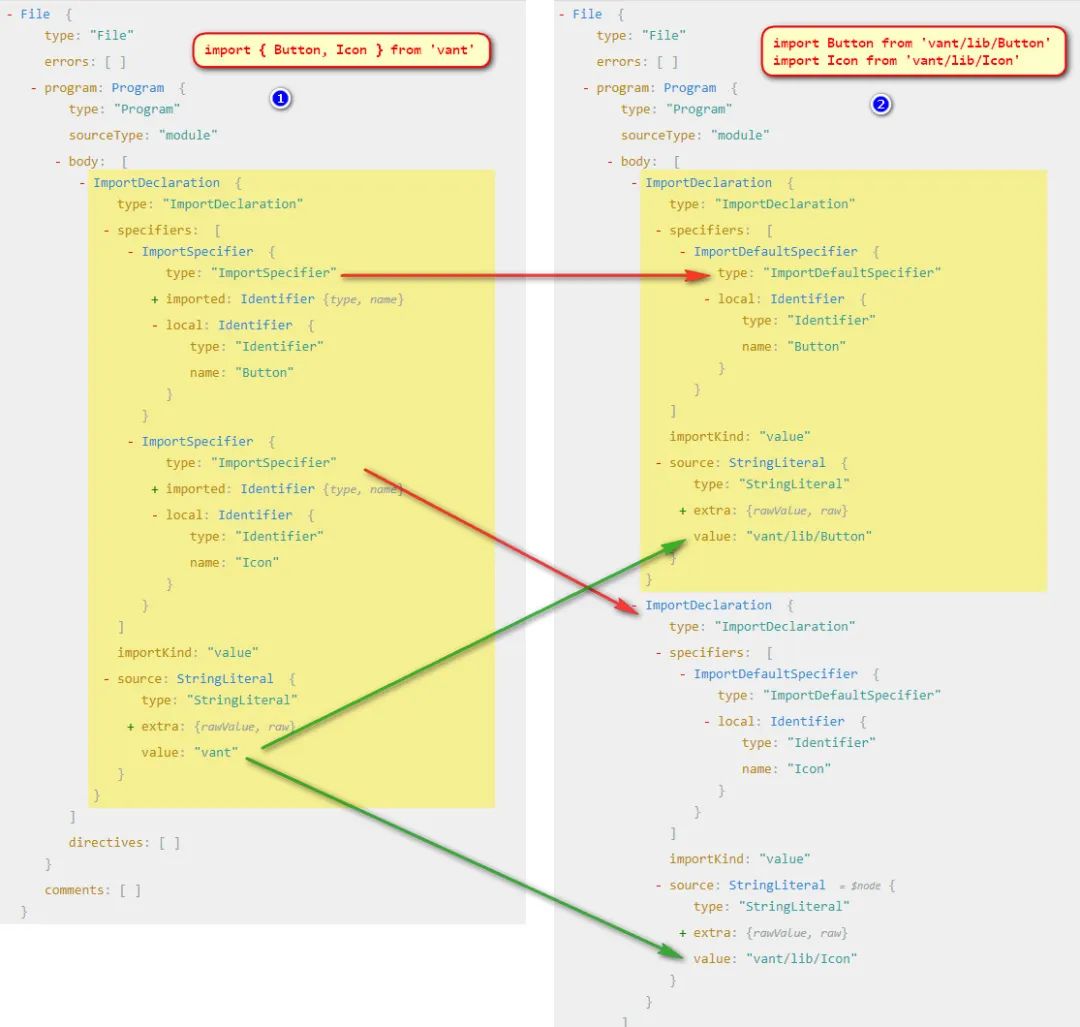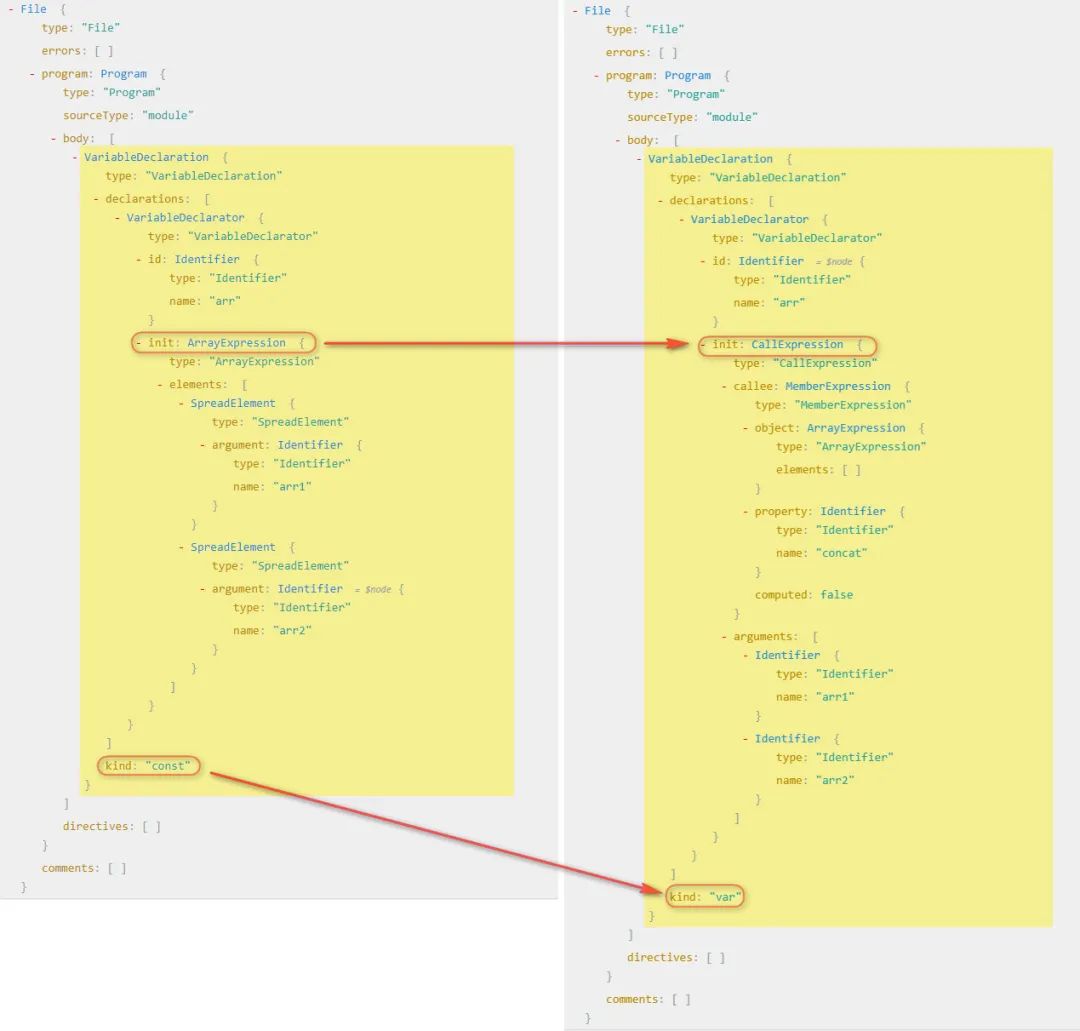原文地址:https://chengyuming.cn/views/webpack/AST.html
抽象语法树(Abstract Syntax Tree)简称 AST,是源代码的抽象语法结构的树状表现形式。webpack、eslint 等很多工具库的核心都是通过抽象语法书这个概念来实现对代码的检查、分析等操作。今天我为大家分享一下 JavaScript 这类解释型语言的抽象语法树的概念
我们常用的浏览器就是通过将 js 代码转化为抽象语法树来进行下一步的分析等其他操作。所以将 js 转化为抽象语法树更利于程序的分析。

左图中对应的:
var 是一个关键字AST 是一个定义者= 是 Equal 等号的叫法有很多形式,在后面我们还会看到is tree 是一个字符串; 就是 Semicoion首先一段代码转换成的抽象语法树是一个对象,该对象会有一个顶级的 type 属性 Program;第二个属性是 body 是一个数组。
body 数组中存放的每一项都是一个对象,里面包含了所有的对于该语句的描述信息
type: 描述该语句的类型 --> 变量声明的语句
kind: 变量声明的关键字 --> var
declaration: 声明内容的数组,里面每一项也是一个对象
type: 描述该语句的类型
id: 描述变量名称的对象
type: 定义
name: 变量的名字
init: 初始化变量值的对象
type: 类型
value: 值 "is tree" 不带引号
row: "\"is tree"\" 带引号JavaScript 是解释型语言,一般通过 词法分析 -> 语法分析 -> 语法树,就可以开始解释执行了
词法分析:也叫扫描,是将字符流转换为记号流(tokens),它会读取我们的代码然后按照一定的规则合成一个个的标识
比如说:var a = 2 ,这段代码通常会被分解成 var、a、=、2
;[
{ type: 'Keyword', value: 'var' },
{ type: 'Identifier', value: 'a' },
{ type: 'Punctuator', value: '=' },
{ type: 'Numeric', value: '2' },
]当词法分析源代码的时候,它会一个一个字符的读取代码,所以很形象地称之为扫描 - scans。当它遇到空格、操作符,或者特殊符号的时候,它会认为一个话已经完成了。
语法分析:也称解析器,将词法分析出来的数组转换成树的形式,同时验证语法。语法如果有错的话,抛出语法错误。
{
...
"type": "VariableDeclarator",
"id": {
"type": "Identifier",
"name": "a"
},
...
}语法分析成 AST ,我们可以在这里在线看到效果 http://esprima.org
比如说,有个函数 function a() {} 我想把它变成 function b() {}
比如说,在 webpack 中代码编译完成后 require('a') --> __webapck__require__("*/**/a.js")
下面来介绍一套工具,可以把代码转成语法树然后改变节点以及重新生成代码
准备工具:
在推荐一个常用的 AST 在线转换网站:https://astexplorer.net/
比如说一段代码 function getUser() {},我们把函数名字更改为 hello,看代码流程
看以下代码,简单说明 AST 遍历流程
const esprima = require('esprima')
const estraverse = require('estraverse')
const code = `function getUser() {}`
// 生成 AST
const ast = esprima.parseScript(code)
// 转换 AST,只会遍历 type 属性
// traverse 方法中有进入和离开两个钩子函数
estraverse.traverse(ast, {
enter(node) {
console.log('enter -> node.type', node.type)
},
leave(node) {
console.log('leave -> node.type', node.type)
},
})输出结果如下:

此时我们发现函数的名字在 type 为 Identifier 的时候就是该函数的名字,我们就可以直接修改它便可实现一个更改函数名字的 AST 工具
// 转换树
estraverse.traverse(ast, {
// 进入离开修改都是可以的
enter(node) {
console.log('enter -> node.type', node.type)
if (node.type === 'Identifier') {
node.name = 'hello'
}
},
leave(node) {
console.log('leave -> node.type', node.type)
},
})
// 生成新的代码
const result = escodegen.generate(ast)
console.log(result)
// function hello() {}提到 AST 我们肯定会想到 babel,自从 Es6 开始大规模使用以来,babel 就出现了,它主要解决了就是一些浏览器不兼容 Es6 新特性的问题,其实就把 Es6 代码转换为 Es5 的代码,兼容所有浏览器,babel 转换代码其实就是用了 AST,babel 与 AST 就有着很一种特别的关系。
那么我们就在 babel 的中来使用 AST,看看 babel 是如何编译代码的(不讲源码啊)
需要用到两个工具包 @babel/core、@babel/preset-env
当我们配置 babel 的时候,不管是在 .babelrc 或者 babel.config.js 文件里面配置的都有 presets 和 plugins 两个配置项(还有其他配置项,这里不做介绍)
// .babelrc
{
"presets": ["@babel/preset-env"],
"plugins": []
}当我们配置了 presets 中有 @babel/preset-env,那么 @babel/core 就会去找 preset-env 预设的插件包,它是一套
babel 核心包并不会去转换代码,核心包只提供一些核心 API,真正的代码转换工作由插件或者预设来完成,比如要转换箭头函数,会用到这个 plugin,@babel/plugin-transform-arrow-functions,当需要转换的要求增加时,我们不可能去一一配置相应的 plugin,这个时候就可以用到预设了,也就是 presets。presets 是 plugins 的集合,一个 presets 内部包含了很多 plugin。
现在我们有一个箭头函数,要想把它转成普通函数,我们就可以直接这么写:
const babel = require('@babel/core')
const code = `const fn = (a, b) => a + b`
// babel 有 transform 方法会帮我们自动遍历,使用相应的预设或者插件转换相应的代码
const r = babel.transform(code, {
presets: ['@babel/preset-env'],
})
console.log(r.code)
// 打印结果如下
// "use strict";
// var fn = function fn() { return a + b; };此时我们可以看到最终代码会被转成普通函数,但是我们,只需要箭头函数转通函数的功能,不需要用这么大一套包,只需要一个箭头函数转普通函数的包,我们其实是可以在 node_modules 下面找到有个叫做 plugin-transform-arrow-functions 的插件,这个插件是专门用来处理 箭头函数的,我们就可以这么写:
const r = babel.transform(code, {
plugins: ['@babel/plugin-transform-arrow-functions'],
})
console.log(r.code)
// 打印结果如下
// const fn = function () { return a + b; };我们可以从打印结果发现此时并没有转换我们变量的声明方式还是 const 声明,只是转换了箭头函数
此时,我们就可以自己来写一些插件,来实现代码的转换,中间处理代码的过程就是使用前面提到的 AST 的处理逻辑
现在我们来个实战把 const fn = (a, b) => a + b 转换为 const fn = function(a, b) { return a + b }
首先我们在在线分析 AST 的网站上分析 const fn = (a, b) => a + b 和 const fn = function(a, b) { return a + b }看两者语法树的区别
根据我们分析可得:
ArrowFunctionExpression,而是函数表达式了 FunctionExpression箭头函数表达式(ArrowFunctionExpression) 转换为 函数表达式(FunctionExpression)二进制表达式(BinaryExpression) 放到一个 代码块中(BlockStatement)在 babel 中,我们开发 plugins 的时候要用到访问者模式,就是说在访问到某一个路径的时候进行匹配,然后在对这个节点进行修改,比如说上面的当我们访问到 ArrowFunctionExpression 的时候,对 ArrowFunctionExpression 进行修改,变成普通函数
那么我们就可以这么写:
const babel = require('@babel/core')
const code = `const fn = (a, b) => a + b` // 转换后 const fn = function(a, b) { return a + b }
const arrowFnPlugin = {
// 访问者模式
visitor: {
// 当访问到某个路径的时候进行匹配
ArrowFunctionExpression(path) {
// 拿到节点
const node = path.node
console.log('ArrowFunctionExpression -> node', node)
},
},
}
const r = babel.transform(code, {
plugins: [arrowFnPlugin],
})
console.log(r)此时我们拿到的结果是这样的节点结果是 这样的,其实就是 ArrowFunctionExpression 的 AST,此时我们要做的是把 ArrowFunctionExpression 的结构替换成 FunctionExpression的结构,但是需要我们组装类似的结构,这么直接写很麻烦,但是 babel 为我们提供了一个工具叫做 @babel/types
@babel/types 有两个作用:
然后我们使用的时候,需要经常查文档,因为里面的节点类型特别多,不是做编译相关工作的是记不住怎么多节点的
那么接下来我们就开始生成一个 FunctionExpression,然后把之前的 ArrowFunctionExpression 替换掉,我们可以看 types 文档,找到 functionExpression,该方法接受相应的参数我们传递过去即可生成一个 FunctionExpression
t.functionExpression(id, params, body, generator, async)BlockStatement 我们需要生成一个还需要生成一个 BlockStatement,我们接着看文档找到 BlockStatement 接受的参数
t.blockStatement(body, directives)看文档说明,blockStatement 接受一个 body,那我们把之前的 body 拿过来就可以直接用,不过这里 body 接受一个数组
我们细看 AST 结构,函数表达式中的 BlockStatement 中的 body 是一个 ReturnStatement,所以我们还需要生成一个 ReturnStatement
现在我们就可以改写 AST 了
const babel = require('@babel/core')
const t = require('@babel/types')
const code = `const fn = (a, b) => a + b` // const fn = function(a, b) { return a + b }
const arrowFnPlugin = {
// 访问者模式
visitor: {
// 当访问到某个路径的时候进行匹配
ArrowFunctionExpression(path) {
// 拿到节点然后替换节点
const node = path.node
console.log('ArrowFunctionExpression -> node', node)
// 拿到函数的参数
const params = node.params
const body = node.body
const functionExpression = t.functionExpression(null, params, t.blockStatement([body]))
// 替换原来的函数
path.replaceWith(functionExpression)
},
},
}
const r = babel.transform(code, {
plugins: [arrowFnPlugin],
})
console.log(r.code) // const fn = function (a, b) { return a + b; };我们知道在剪头函数中是可以省略 return 关键字,我们上面是处理了省略关键字的写法,但是如果用户写了 return 关键字后,我们写的这个插件就有问题了,所以我们可以在优化一下
const fn = (a, b) => { retrun a + b } -> const fn = function(a, b) { return a + b }
观察代码我们发现,我们就不需要把 body 转换成 blockStatement 了,直接放过去就可以了,那么我们就可以这么写
ArrowFunctionExpression(path) {
// 拿到节点然后替换节点
const node = path.node
console.log("ArrowFunctionExpression -> node", node)
// 拿到函数的参数
const params = node.params
let body = node.body
// 判断是不是 blockStatement,不是的话让他变成 blockStatement
if (!t.isBlockStatement(body)) {
body = t.blockStatement([body])
}
const functionExpression = t.functionExpression(null, params, body)
// 替换原来的函数
path.replaceWith(functionExpression)
}在开发中,我们引入 UI 框架,比如 vue 中用到的 element-ui,vant 或者 React 中的 antd 都支持全局引入和按需引入,默认是全局引入,如果需要按需引入就需要安装一个 babel-plugin-import 的插件,将全局的写法变成按需引入的写法。
就拿我最近开发移动端用的 vant 为例, import { Button } from 'vant' 这种写法经过这个插件之后会变成 import Button from 'vant/lib/Button' 这种写法,引用整个 vant 变成了我只用了 vant 下面的某一个文件,打包后的文件会比全部引入的文件大小要小很多
import { Button, Icon } from 'vant'写法转换为import Button from 'vant/lib/Button'; import Icon from 'vant/lib/Icon'
看一下两个语法树的区别

specifiers)是两个 ImportSpecifier,第二张图里面是分开的,而且都是 ImportDefaultSpecifiersource 也不一样ImportDeclaration 变成多个 ImportDeclaration, 然后把单个 import 解构引入的 specifiers 部分 ImportSpecifier 转换成多个 ImportDefaultSpecifier 并修改对应的 source 即可为了方便传递参数,这次我们写到一个函数里面,可以方便传递转换后拼接的目录
这里我们需要用到的几个类型,也需要在 types 官网上找对应的解释
importDeclaration 类型 /**
* @param {Array<ImportSpecifier | ImportDefaultSpecifier | ImportNamespaceSpecifier>} specifiers (required)
* @param {StringLiteral} source (required)
*/
t.importDeclaration(specifiers, source)importDeclaration 中需要生成 ImportDefaultSpecifier /**
* @param {Identifier} local (required)
*/
t.importDefaultSpecifier(local)importDeclaration 中还需要生成一个 StringLiteral /**
* @param {string} value (required)
*/
t.stringLiteral(value)按照上面的分析,我们开始上代码
const babel = require('@babel/core')
const t = require('@babel/types')
const code = `import { Button, Icon } from 'vant'`
// import Button from 'vant/lib/Button'
// import Icon from 'vant/lib/Icon'
function importPlugin(opt) {
const { libraryDir } = opt
return {
visitor: {
ImportDeclaration(path) {
const node = path.node
// console.log("ImportDeclaration -> node", node)
// 得到节点的详细说明,然后转换成多个的 import 声明
const specifiers = node.specifiers
// 要处理这个我们做一些判断,首先判断不是默认导出我们才处理,要考虑 import vant, { Button, Icon } from 'vant' 写法
// 还要考虑 specifiers 的长度,如果长度不是 1 并且不是默认导出我们才需要转换
if (!(specifiers.length === 1 && t.isImportDefaultSpecifier(specifiers[0]))) {
const result = specifiers.map((specifier) => {
const local = specifier.local
const source = t.stringLiteral(`${node.source.value}/${libraryDir}/${specifier.local.name}`)
// console.log("ImportDeclaration -> specifier", specifier)
return t.importDeclaration([t.importDefaultSpecifier(local)],source)
})
console.log('ImportDeclaration -> result', result)
// 因为这次要替换的 AST 不是一个,而是多个的,所以需要 `path.replaceWithMultiple(result)` 来替换,但是一执行发现死循环了
path.replaceWithMultiple(result)
}
},
},
}
}
const r = babel.transform(code, {
plugins: [importPlugin({ libraryDir: 'lib' })],
})
console.log(r.code)看打印结果和转换结果似乎没什么问题,这个插件几乎就实现了
但是我们考虑一种情况,如果用户不全部按需加载了,按需加载只是一种选择,如果用户这么写了 import vant, { Button, Icon } from 'vant',那么我们这个插件就出现问题了
如果遇到这种写法,那么默认导入的他的 source 应该是不变的,我们要把原来的 source 拿出来
所以还需要判断一下,每一个 specifier 是不是一个 ImportDefaultSpecifier 然后处理不同的 source,完整处理逻辑应该如下
function importPlugin(opt) {
const { libraryDir } = opt
return {
visitor: {
ImportDeclaration(path) {
const node = path.node
// console.log("ImportDeclaration -> node", node)
// 得到节点的详细说明,然后转换成多个的 import 声明
const specifiers = node.specifiers
// 要处理这个我们做一些判断,首先判断不是默认导出我们才处理,要考虑 import vant, { Button, Icon } from 'vant' 写法
// 还要考虑 specifiers 的长度,如果长度不是 1 并且不是默认导出我们才需要转换
if (
!(
specifiers.length === 1 && t.isImportDefaultSpecifier(specifiers[0])
)
) {
const result = specifiers.map((specifier) => {
let local = specifier.local,
source
// 判断是否存在默认导出的情况
if (t.isImportDefaultSpecifier(specifier)) {
source = t.stringLiteral(node.source.value)
} else {
source = t.stringLiteral(
`${node.source.value}/${libraryDir}/${specifier.local.name}`
)
}
return t.importDeclaration(
[t.importDefaultSpecifier(local)],
source
)
})
path.replaceWithMultiple(result)
}
},
},
}
}在 babel 官网上有一句话 Babylon is a JavaScript parser used in Babel.
babel 使用的引擎是 babylon,Babylon 并非 babel 团队自己开发的,而是 fork 的 acorn 项目,acorn 的项目本人在很早之前在兴趣部落 1.0 在构建中使用,为了是做一些代码的转换,是很不错的一款引擎,不过 acorn 引擎只提供基本的解析 ast 的能力,遍历还需要配套的 acorn-travesal, 替换节点需要使用 acorn-,而这些开发,在 Babel 的插件体系开发下,变得一体化了(摘自 AlloyTeam 团队的剖析 babel)
使用 babylon 编写一个数组 rest 转 Es5 语法的插件
把 const arr = [ ...arr1, ...arr2 ] 转成 var arr = [].concat(arr1, arr2)
我们使用 babylon 的话就不需要使用 @babel/core 了,只需要用到他里面的 traverse 和 generator,用到的包有 babylon、@babel/traverse、@babel/generator、@babel/types
先来看一下两棵语法树的区别

这段代码的核心生成一个 callExpression 调用表达式,所以对应官网上的类型,我们分析需要用到的 api
/**
* @param {Expression} callee (required)
* @param {Array<Expression | SpreadElement | JSXNamespacedName>} source (required)
*/
t.callExpression(callee, arguments)/**
* @param {Expression} object (required)
* @param {if computed then Expression else Identifier} property (required)
* @param {boolean} computed (default: false)
* @param {boolean} optional (default: null)
*/
t.memberExpression(object, property, computed, optional) /**
* @param {Array<null | Expression | SpreadElement>} elements (default: [])
*/
t.arrayExpression(elements)/**
* @param {LVal} id (required)
* @param {Expression} init (default: null)
*/
t.variableDeclarator(id, init)
/**
* @param {"var" | "let" | "const"} kind (required)
* @param {Array<VariableDeclarator>} declarations (required)
*/
t.variableDeclaration(kind, declarations)const babylon = require('babylon')
// 使用 babel 提供的包,traverse 和 generator 都是被暴露在 default 对象上的
const traverse = require('@babel/traverse').default
const generator = require('@babel/generator').default
const t = require('@babel/types')
const code = `const arr = [ ...arr1, ...arr2 ]` // var arr = [].concat(arr1, arr2)
const ast = babylon.parse(code, {
sourceType: 'module',
})
// 转换树
traverse(ast, {
VariableDeclaration(path) {
const node = path.node
const declarations = node.declarations
console.log('VariableDeclarator -> declarations', declarations)
const kind = 'var'
// 边界判定
if (node.kind !== kind && declarations.length === 1 && t.isArrayExpression(declarations[0].init)) {
// 取得之前的 elements
const args = declarations[0].init.elements.map((item) => item.argument)
const callee = t.memberExpression(t.arrayExpression(), t.identifier('concat'), false)
const init = t.callExpression(callee, args)
const declaration = t.variableDeclarator(declarations[0].id, init)
const variableDeclaration = t.variableDeclaration(kind, [declaration])
path.replaceWith(variableDeclaration)
}
},
})和抽象语法树相对的是具体语法树(Concrete Syntax Tree)简称 CST(通常称作分析树)。一般的,在源代码的翻译和编译过程中,语法分析器创建出分析树。一旦 AST 被创建出来,在后续的处理过程中,比如语义分析阶段,会添加一些信息。可参考抽象语法树和具体语法树有什么区别?
关于 node 类型,全集大致如下:
(parameter) node: Identifier | SimpleLiteral | RegExpLiteral | Program | FunctionDeclaration | FunctionExpression | ArrowFunctionExpression | SwitchCase | CatchClause | VariableDeclarator | ExpressionStatement | BlockStatement | EmptyStatement | DebuggerStatement | WithStatement | ReturnStatement | LabeledStatement | BreakStatement | ContinueStatement | IfStatement | SwitchStatement | ThrowStatement | TryStatement | WhileStatement | DoWhileStatement | ForStatement | ForInStatement | ForOfStatement | VariableDeclaration | ClassDeclaration | ThisExpression | ArrayExpression | ObjectExpression | YieldExpression | UnaryExpression | UpdateExpression | BinaryExpression | AssignmentExpression | LogicalExpression | MemberExpression | ConditionalExpression | SimpleCallExpression | NewExpression | SequenceExpression | TemplateLiteral | TaggedTemplateExpression | ClassExpression | MetaProperty | AwaitExpression | Property | AssignmentProperty | Super | TemplateElement | SpreadElement | ObjectPattern | ArrayPattern | RestElement | AssignmentPattern | ClassBody | MethodDefinition | ImportDeclaration | ExportNamedDeclaration | ExportDefaultDeclaration | ExportAllDeclaration | ImportSpecifier | ImportDefaultSpecifier | ImportNamespaceSpecifier | ExportSpecifierBabel 有文档对 AST 树的详细定义,可参考这里
代码以存放到 GitHub,地址:https://github.com/fecym/ast-share
本文由哈喽比特于5年以前收录,如有侵权请联系我们。
文章来源:https://mp.weixin.qq.com/s/-pvoF4vd9jaUEdj0w2zOzA
京东创始人刘强东和其妻子章泽天最近成为了互联网舆论关注的焦点。有关他们“移民美国”和在美国购买豪宅的传言在互联网上广泛传播。然而,京东官方通过微博发言人发布的消息澄清了这些传言,称这些言论纯属虚假信息和蓄意捏造。
日前,据博主“@超能数码君老周”爆料,国内三大运营商中国移动、中国电信和中国联通预计将集体采购百万台规模的华为Mate60系列手机。
据报道,荷兰半导体设备公司ASML正看到美国对华遏制政策的负面影响。阿斯麦(ASML)CEO彼得·温宁克在一档电视节目中分享了他对中国大陆问题以及该公司面临的出口管制和保护主义的看法。彼得曾在多个场合表达了他对出口管制以及中荷经济关系的担忧。
今年早些时候,抖音悄然上线了一款名为“青桃”的 App,Slogan 为“看见你的热爱”,根据应用介绍可知,“青桃”是一个属于年轻人的兴趣知识视频平台,由抖音官方出品的中长视频关联版本,整体风格有些类似B站。
日前,威马汽车首席数据官梅松林转发了一份“世界各国地区拥车率排行榜”,同时,他发文表示:中国汽车普及率低于非洲国家尼日利亚,每百户家庭仅17户有车。意大利世界排名第一,每十户中九户有车。
近日,一项新的研究发现,维生素 C 和 E 等抗氧化剂会激活一种机制,刺激癌症肿瘤中新血管的生长,帮助它们生长和扩散。
据媒体援引消息人士报道,苹果公司正在测试使用3D打印技术来生产其智能手表的钢质底盘。消息传出后,3D系统一度大涨超10%,不过截至周三收盘,该股涨幅回落至2%以内。
9月2日,坐拥千万粉丝的网红主播“秀才”账号被封禁,在社交媒体平台上引发热议。平台相关负责人表示,“秀才”账号违反平台相关规定,已封禁。据知情人士透露,秀才近期被举报存在违法行为,这可能是他被封禁的部分原因。据悉,“秀才”年龄39岁,是安徽省亳州市蒙城县人,抖音网红,粉丝数量超1200万。他曾被称为“中老年...
9月3日消息,亚马逊的一些股东,包括持有该公司股票的一家养老基金,日前对亚马逊、其创始人贝索斯和其董事会提起诉讼,指控他们在为 Project Kuiper 卫星星座项目购买发射服务时“违反了信义义务”。
据消息,为推广自家应用,苹果现推出了一个名为“Apps by Apple”的网站,展示了苹果为旗下产品(如 iPhone、iPad、Apple Watch、Mac 和 Apple TV)开发的各种应用程序。
特斯拉本周在美国大幅下调Model S和X售价,引发了该公司一些最坚定支持者的不满。知名特斯拉多头、未来基金(Future Fund)管理合伙人加里·布莱克发帖称,降价是一种“短期麻醉剂”,会让潜在客户等待进一步降价。
据外媒9月2日报道,荷兰半导体设备制造商阿斯麦称,尽管荷兰政府颁布的半导体设备出口管制新规9月正式生效,但该公司已获得在2023年底以前向中国运送受限制芯片制造机器的许可。
近日,根据美国证券交易委员会的文件显示,苹果卫星服务提供商 Globalstar 近期向马斯克旗下的 SpaceX 支付 6400 万美元(约 4.65 亿元人民币)。用于在 2023-2025 年期间,发射卫星,进一步扩展苹果 iPhone 系列的 SOS 卫星服务。
据报道,马斯克旗下社交平台𝕏(推特)日前调整了隐私政策,允许 𝕏 使用用户发布的信息来训练其人工智能(AI)模型。新的隐私政策将于 9 月 29 日生效。新政策规定,𝕏可能会使用所收集到的平台信息和公开可用的信息,来帮助训练 𝕏 的机器学习或人工智能模型。
9月2日,荣耀CEO赵明在采访中谈及华为手机回归时表示,替老同事们高兴,觉得手机行业,由于华为的回归,让竞争充满了更多的可能性和更多的魅力,对行业来说也是件好事。
《自然》30日发表的一篇论文报道了一个名为Swift的人工智能(AI)系统,该系统驾驶无人机的能力可在真实世界中一对一冠军赛里战胜人类对手。
近日,非营利组织纽约真菌学会(NYMS)发出警告,表示亚马逊为代表的电商平台上,充斥着各种AI生成的蘑菇觅食科普书籍,其中存在诸多错误。
社交媒体平台𝕏(原推特)新隐私政策提到:“在您同意的情况下,我们可能出于安全、安保和身份识别目的收集和使用您的生物识别信息。”
2023年德国柏林消费电子展上,各大企业都带来了最新的理念和产品,而高端化、本土化的中国产品正在不断吸引欧洲等国际市场的目光。
罗永浩日前在直播中吐槽苹果即将推出的 iPhone 新品,具体内容为:“以我对我‘子公司’的了解,我认为 iPhone 15 跟 iPhone 14 不会有什么区别的,除了序(列)号变了,这个‘不要脸’的东西,这个‘臭厨子’。









